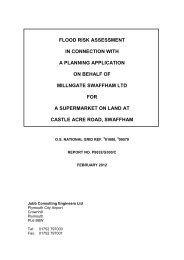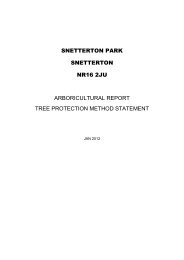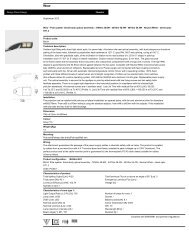view - Breckland Council
view - Breckland Council
view - Breckland Council
You also want an ePaper? Increase the reach of your titles
YUMPU automatically turns print PDFs into web optimized ePapers that Google loves.
iii. The Impact of the Proposal on the Allocated Sites outside Town Centres being developed in<br />
accordance with the Development Plan<br />
7.24 As outlined in Section 3 of this Statement, an outline planning application has been submitted by The<br />
Crown Estate and Kilverstone Estate for the Thetford Urban Extension; this is the principal allocation in<br />
both the adopted <strong>Breckland</strong> Core Strategy and the emerging TAAP. Although that application envisages<br />
a quantum of local retail units (to serve the local population) the scheme is residential (500 houses) and<br />
employment (22ha) led. The application proposals would in no way prevent this scheme from being<br />
delivered.<br />
iv. In the context of a retail or leisure proposal, the impact of the proposal on in centre<br />
trade/turnover and on trade in the wider area, taking account of current and future consumer<br />
expenditure capacity in the catchment area up to five years from the time the application is<br />
made, and, where applicable, on the rural economy<br />
7.25 Again, the PPS4 Practice Guidance gives a helpful explanation as to the way in which this impact should<br />
be assessed. Importantly, paragraph 7.29 of that Guidance states that:<br />
“It will be necessary to balance the desirability of maintaining and enhancing<br />
the turnover of existing centres with the benefits of improved consumer<br />
choice, competition and access to new facilities. In this respect, there are no<br />
meaningful benchmarks of what constitutes an ‘acceptable’ level of trade<br />
diversion resulting from such proposals. The relevant factors will depend on<br />
the circumstances of each case.”<br />
7.26 It goes on, at paragraph 7.32, to advise that:<br />
“Where a centre is experiencing falling rents, high levels of vacancy and<br />
declining footfall, even modest levels of trade diversion can have significant<br />
adverse impacts. Where centres are vital and viable, and existing<br />
retailers/leisure operators are achieving high levels of turnover, they may be<br />
able to withstand high levels of trade diversion resulting from a proposal,<br />
although this does not mean in itself that such impacts are acceptable. In<br />
most cases, unless there is clear evidence of a significant impact on turnover<br />
likely to undermine the vitality and viability of the centre, the negative effect<br />
of trade diversion needs to be balanced against any positive town centre or<br />
wider impacts as part of reaching an overall judgement.”<br />
7.27 NLP’s analysis certainly does not suggest Thetford is a weak or vulnerable centre and that is confirmed<br />
by our own health check.<br />
7.28 Annex D of the PPS4 Practice Guidance sets out a framework for making judgements about the likely<br />
extent of trade diversion – where possible, this framework has been adopted in the following analysis.<br />
Step 1: Establish the Base and Design Years and Define the Catchment Area<br />
7.29 Paragraph D.2 of the Practice Guidance advises that for site specific proposals the design year should<br />
normally be taken as one to two years after the likely completion of a development. Mindful of this<br />
advice and assuming completion of the development by the end of 2013, we have taken a design year<br />
Former Tulip Factory Site, London Road/Caxton Way, Thetford Page 34<br />
Retail & Planning Statement, February 2012














